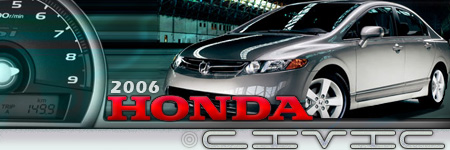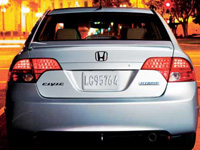
The
Honda Civic's title as America's best-selling compact
car is safe. The new, eighth-generation Civic for
2006 offers more of what consumers look for: A roomier
interior than its predecessor, more powerful and fuel-efficient
engines and more safety features. The new Civic also
is decidedly sleeker and more upscale in its looks,
especially as a two-door coupe.
The bad news: Prices have increased. For the base
Civic sedan, the manufacturer's suggested retail price,
including destination charge, tops $15,000 for the
first time. This is up some $1,200 from the price
of a base, 2005 Civic sedan.
Indeed, as of 2006, the base Civic sedan carries MSRP
pricing, including destination charge, that's higher
than several competitors, including the 2006 Toyota
Corolla and the 2006 Nissan Sentra. And base pricing
for the gasoline-electric 2006 Civic Hybrid is up
$2,000 from its 2005 predecessor and now tops $22,000.
Honda's Civic dates to 1973 in the United States. A
little hatchback, it was the first high-volume Honda
sold in the U.S. Over the years, the Civic grew larger
and added models. In recent years, the Civic's average
annual U.S. sales of approximately 300,000 have made
it the top-selling compact car in the country. Last
year, it also was the third best-selling car overall.
Besides the sedan and coupe, the Civic line includes
the high-performance model, Si, and the gasoline-electric
Civic Hybrid.
For 2006, each Civic has a more distinct personality.
The Civic coupe, for example, doesn't share outer
body sheet metal panels with the Civic sedan. And
the Civic Si gets a big increase in horsepower — to
197 from last year's 160 and compares with the Civic
sedan's 140 horsepower. The Si also now rides on the
largest standard Civic tires, 17-inchers, ever.
Meantime, the Civic Hybrid provides a different driving
experience. With a hybrid powerplant can run the vehicle solely on electric power
in certain driving situations for the first time. The hybrid's fuel economy
rating has alsoimproved — to 49 miles a gallon in
city driving and 51 mpg in highway driving. This is an increase from
47/48 mpg for the 2005 model.
All the new Civics benefit from a new front-wheel-drive
platform that provides a tighter-feeling, more refined
ride. The new MacPherson strut front suspension and
rear multi-link double wishbone configuration allowed
engineers to more finely tune the handling and ride
for a better fit with each Civic. For example, the
Civic sedan keeps jolting bumps away from passengers
in an upscale ride, while the Civic Si's sporty ride
conveys most road bumps and vibrations to passengers.
The Civic sedans also are quieter inside compared
with the Civic Si, and they're noticeably quieter
compared with their predecessors. Road noise, in particular, is muted in the four-door
models compared with the Si with its sport-oriented
tires.
The new, power-assisted rack-and-pinion steering is
more responsive in all Civics and took a bit of getting
used to. The Civic steering wheel is compact, and
combined with the new, quick steering gear ratios,
gave me the feeling I was at the controls of a video
game. This sensation wore off over time.
Front-seat passengers are bound to notice the prominent rake of the windshield. Seats are a bit wider and redesigned for improved comfort, and interior plastics have a quality appearance. But the Civic horn still sounds wimpy.
All Civic interiors now feature a more high-tech dashboard where the gauges in front of the driver are split between a curved arrangement up near the windshield and a lower group located in the traditional spot behind the steering wheel. Honda officials said the effect is a pseudo head-up display, like that found on some more-expensive, sporty cars where pertinent driver information, such as speed, is projected onto the lower part of the windshield so a driver doesn't have to divert his or her eyes from the road. But in the Civic, this arrangement contributed to my initial reaction that I was in front of a video game, rather than driving on a real road. Again, the sensation passed as I spent more time in the driver's seat.
More powerful engines are new across the Civic line and continue to be four-cylinder powerplants. The 140-horsepower, 1.8-liter, single overhead cam, inline four cylinder with Honda's i-VTEC variable valve timing system in the Civic coupe and sedan is rated at an impressive 40 miles a gallon in highway driving. The rating is 30 mpg in city travel. This is for a Civic with new five-speed, automatic transmission that's the first five-speed automatic in the compact car class. The power came on in a peppy manner in the test sedan with the automatic. I especially liked how the Civic sedan accelerated with improved vitality across a wide range of driving situations, including on the highway. Maximum torque is 128 foot-pounds at 4,300 rpm.
In comparison, the Toyota Corolla offers two four-cylinder engines. One has 126 horsepower with 122 foot-pounds of torque at 4,200 rpm, while the other delivers 164 horsepower and 125 foot-pounds of torque at 4,400 rpm.
The Nissan Sentra also is available with two four-cylinder engines. A 126-horsepower, 1.8-liter unit delivers 129 foot-pounds at 2,400 rpm, while the uplevel, 165-horsepower four generates 175 foot-pounds of torque at 4,000 rpm.
In the Civic Hybrid, power comes from a 1.3-liter, single overhead cam, inline four cylinder gas engine and a 15-kilowatt electric motor. The engine puts out 93 horsepower and 89 foot-pounds of torque at 4,500 rpm, while the electric motor can generate up to 20 horsepower and 76 foot-pounds of torque right from startup.
 |
The result: A maximum combined output of 110 horsepower vs. 93 in the 2005 Civic Hybrid and 123 foot-pounds of torque at 2,500 rpm compared with last year's 116 foot-pounds. The changes are noticeable when a driver presses the accelerator to get started and during passing maneuvers, where the Civic Hybrid moves with a quick response and steady delivery of power.
Yet, fuel economy is improved, too, resulting in a Civic Hybrid that can travel 615 miles or more before a fillup. The Civic Hybrid's fuel economy rating also makes it the thriftiest compact car available.
Safety enhancements in all Civics include standard frontal airbags and side-mounted airbags for the front-seat passengers as well as side curtain airbags to protect front- and rear-seat passengers during a side crash. 2006 Civic also is the first with active head restraints, which are designed to help minimize whiplash injuries during a rear-end collision. Other standard safety equipment includes antilock brakes and Electronic Brake Distribution.
It's expected that the new Civics will retain the reliability and quality that predecessors had. For years, the Civic has been rated one of the top small cars in initial quality by buyers in an annual J.D. Power and Associates study. Baby Boomers have been a major buyer group for the Civic over the years. But Honda officials said the new-generation Civic is targeted to appeal to the growing number of Gen Y buyers.
They "are starting to have an influence on car sales," said Toshiro Morita, large project leader for Honda. "They look for leading edge products with styling, performance and innovation."
| For more information visit the Honda website here. |
|